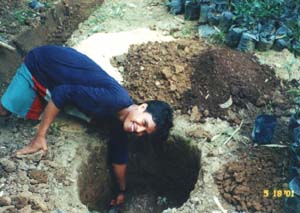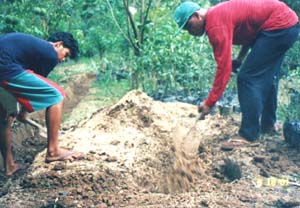|
|
|
Practical Guide to Backyard and Orchard Farming |
|
SOIL REQUIREMENT |
|
|
|
The soil
should be fertile, deep, well drained, and with good
aeration. Sandy, loamy or clay loam soil which is high in
organic matter is the most ideal.
Heavy
clay soil and marginal soil can be improved by digging
bigger planting hole and mixing the top soil with rice hull,
sawdust or sand and carabao manure or compost to improve
fertility and to promote aeration.
Land Preparation
Plow and harrow the soil until it is pulverized. Do not work
the soil when wet because the soil structure will be
destroyed making the clay soil more compact. To completely
eliminate weeds especially cogon, plowing should be done
during the dry season or at least 2-3 months before the
rainy season.
Place
stakes in the areas where the trees shall be planted.
Distancing shall be based on the growth performance of the
cultivar. Before removing the stakes when digging, the hole
must have another guide mark or planting board to make sure
that the trees shall form straight rows when planted. Put a
6-inch stake on both sides of the hole as planting board.
Locate it 1 1/2 to 2 feet from the middle of the hole. This
will be the guide where the tree shall be planted which
shall be at the middle of the two small stakes. |
| |
|
 |
If
your soil is heavy clay, dig 2 feet x 2 feet x 2
feet. The poorer the soil, the bigger the hole
should be. Loam black soil, on the other hand, can
be smaller up to 1 foot x 1 foot x 1 foot. |
|
| For heavy clay and
poor soil, mix it with two sacks of rice hull,
sawdust or sand and one sack of carabao, horse or
cow manure. Mix thoroughly. |
 |
|
|
Note: Do not use fresh chicken
manure because it will produce methane gas during
decomposition damaging the roots of the cultivars. |
|
|
|
DIZON EXOTIC FRUIT TREES |
| Department
of Agriculture - Bureau of Plant Industry |
| Accredited
Plant Nursery Operator with Certificate Number
0804-07 |
|
|
|

